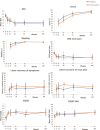Surgical versus conservative treatment for odontoid fractures in older people: an international prospective comparative study
- PMID: 39193720
- PMCID: PMC11350288
- DOI: 10.1093/ageing/afae189
Surgical versus conservative treatment for odontoid fractures in older people: an international prospective comparative study
Abstract
Background: The optimal treatment for odontoid fractures in older people remains debated. Odontoid fractures are increasingly relevant to clinical practice due to ageing of the population.
Methods: An international prospective comparative study was conducted in fifteen European centres, involving patients aged ≥55 years with type II/III odontoid fractures. The surgeon and patient jointly decided on the applied treatment. Surgical and conservative treatments were compared. Primary outcomes were Neck Disability Index (NDI) improvement, fracture union and stability at 52 weeks. Secondary outcomes were Visual Analogue Scale neck pain, Likert patient-perceived recovery and EuroQol-5D-3L at 52 weeks. Subgroup analyses considered age, type II and displaced fractures. Multivariable regression analyses adjusted for age, gender and fracture characteristics.
Results: The study included 276 patients, of which 144 (52%) were treated surgically and 132 (48%) conservatively (mean (SD) age 77.3 (9.1) vs. 76.6 (9.7), P = 0.56). NDI improvement was largely similar between surgical and conservative treatments (mean (SE) -11 (2.4) vs. -14 (1.8), P = 0.08), as were union (86% vs. 78%, aOR 2.3, 95% CI 0.97-5.7) and stability (99% vs. 98%, aOR NA). NDI improvement did not differ between patients with union and persistent non-union (mean (SE) -13 (2.0) vs. -12 (2.8), P = 0.78). There was no difference for any of the secondary outcomes or subgroups.
Conclusions: Clinical outcome and fracture healing at 52 weeks were similar between treatments. Clinical outcome and fracture union were not associated. Treatments should prioritize favourable clinical over radiological outcomes.
Keywords: conservative treatment; odontoid fractures; older people; surgical treatment; treatment outcome.
© The Author(s) 2024. Published by Oxford University Press on behalf of Institute of Chartered Foresters.
Conflict of interest statement
None.
Figures
References
-
- Grauer JN, Shafi B, Hilibrand ASet al. . Proposal of a modified, treatment-oriented classification of odontoid fractures. Spine J 2005; 5: 123–9. - PubMed
-
- Daniels AH, Arthur M, Esmende SM, Vigneswaran H, Palumbo MA. Incidence and cost of treating axis fractures in the United States from 2000 to 2010. Spine (Phila Pa 1976) 2014; 39: 1498–505. - PubMed
-
- Alluri R, Bouz G, Solaru S, Kang H, Wang J, Hah RJ. A Nationwide analysis of geriatric odontoid fracture incidence, complications, mortality, and cost. Spine (Phila Pa 1976) 2021; 46: 131–7. - PubMed
Publication types
MeSH terms
Grants and funding
LinkOut - more resources
Full Text Sources
Medical



